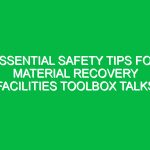Introduction
Compressed air is a powerful tool widely used across various industries, from manufacturing to healthcare. It serves numerous purposes, including powering pneumatic tools, cleaning surfaces, and even operating machinery. However, the question remains: is compressed air dangerous? Understanding its risks is crucial within the Health, Safety, and Environment (HSE) domain.
In this article, we will explore the complexities surrounding the Safety of compressed air, identifying potential Hazards, safety Precautions, and regulatory Standards that govern its use. The goal is not only to inform but also to empower individuals and organizations to make safe decisions regarding the handling and use of compressed air.
The Nature of Compressed Air
Compressed air is simply air that has been compressed to a pressure greater than atmospheric pressure. This compression increases its energy, making it an effective source of power. However, this very energy can pose significant risks if not managed properly.
Understanding the Risks of Compressed Air
While compressed air is invaluable in many settings, it can be dangerous in several ways:
- High-Pressure Hazards: Compressed air is stored under high pressure, which can lead to explosive discharges if equipment fails or is misused.
- Injury from Air Jets: Air jets can cause serious injuries, including lung damage, skin punctures, and eye injuries if aimed at people.
- Noise Pollution: The use of compressed air can generate high noise levels, leading to hearing loss over time.
- Contaminants: If air systems are not properly maintained, contaminants can be introduced, posing health risks to workers.
Each of these risks highlights the importance of understanding how to handle compressed air safely.
Case Study: Real-World Incidents
To illustrate the dangers associated with compressed air, consider a case from the manufacturing sector. A worker was using compressed air to clean machinery when the air hose malfunctioned, resulting in a high-pressure jet that struck his arm. The injury led to a severe laceration and required extensive medical treatment. This incident serves as a reminder of the potential hazards and emphasizes the need for strict Safety protocols.
Best Practices for Safe Use of Compressed Air
To mitigate the dangers associated with compressed air, organizations should adopt Best Practices tailored to HSE guidelines. Here are several key strategies:
1. Training and Awareness
It is essential for all employees who handle compressed air to receive proper Training. This training should cover:
- Understanding the properties of compressed air.
- Safe Operation of air tools.
- Emergency Procedures in the event of an air-related accident.
Regular refresher courses can help keep safety practices top-of-mind.
2. Use of Personal Protective Equipment (PPE)
Ensuring that employees wear appropriate PPE when working with compressed air is crucial. This may include:
- Safety Goggles to protect against flying debris.
- Ear protection to mitigate noise exposure.
- Gloves and protective clothing to prevent skin injuries.
3. Regular Maintenance of Equipment
Compressed air systems must be regularly inspected and maintained to prevent equipment failure. This includes:
- Checking hoses for leaks and wear.
- Inspecting pressure regulators and gauges for accuracy.
- Ensuring that filters are clean and functioning properly.
4. Proper Storage and Handling
When storing compressed air cylinders, it is important to follow Safety Guidelines, such as:
- Securing cylinders in an upright position.
- Avoiding exposure to heat or direct sunlight.
- Keeping cylinders away from flammable materials.
Potential Hazards and Safety Considerations
Understanding the potential hazards associated with compressed air is vital for promoting safety. Some of the most common dangers include:
1. Airborne Particles
Compressed air can carry dust, oil, and other contaminants that may pose health risks. A study conducted in a factory environment found that workers exposed to contaminated compressed air had higher instances of respiratory issues. Regular maintenance and filtration of compressed air systems can help mitigate these risks.
2. Risk of Fire and Explosion
The high-pressure nature of compressed air systems can lead to catastrophic failures if not properly managed. There have been instances where improperly maintained systems have exploded, causing extensive damage and injuries. Implementing strict maintenance protocols and regular inspections can minimize this risk.
3. Ergonomic Risks
Workers using pneumatic tools may be at risk of developing musculoskeletal disorders due to repetitive motions and improper handling. Ergonomic assessments and the introduction of better tool designs can help alleviate these risks.
Regulations and Standards Governing Compressed Air Use
In the HSE context, several Regulations and standards govern the safe use of compressed air. Understanding these regulations is essential for compliance and safety.
1. OSHA Standards
In the United States, the Occupational Safety and Health Administration (osha) sets forth regulations regarding the use of compressed air. These regulations cover aspects such as:
- Proper training for employees handling compressed air.
- Maintenance requirements for air systems.
- Use of PPE.
2. ANSI Standards
The American National Standards Institute (ANSI) also provides guidelines related to the safe use of compressed air. These standards focus on equipment design and operational safety, ensuring that systems are built and used according to established safety criteria.
3. ISO Standards
The International Organization for Standardization (ISO) has established standards that cover various aspects of compressed air systems, including quality control and safety practices. Compliance with these standards can help organizations maintain a safe working environment.
Conclusion
In conclusion, the question of whether compressed air is dangerous is multifaceted. While it is an invaluable resource in many industries, the potential hazards it poses cannot be overlooked. By adhering to Best Practices, implementing regular training, and complying with relevant regulations, organizations can significantly reduce the risks associated with compressed air.
As we’ve explored, the dangers of compressed air are real and can lead to severe consequences. However, with the right knowledge and procedures in place, the safe use of compressed air can be maintained, promoting both Workplace Safety and environmental Sustainability. It’s imperative to foster a culture of safety and continuous improvement in handling compressed air technologies to protect workers and the environment alike.


